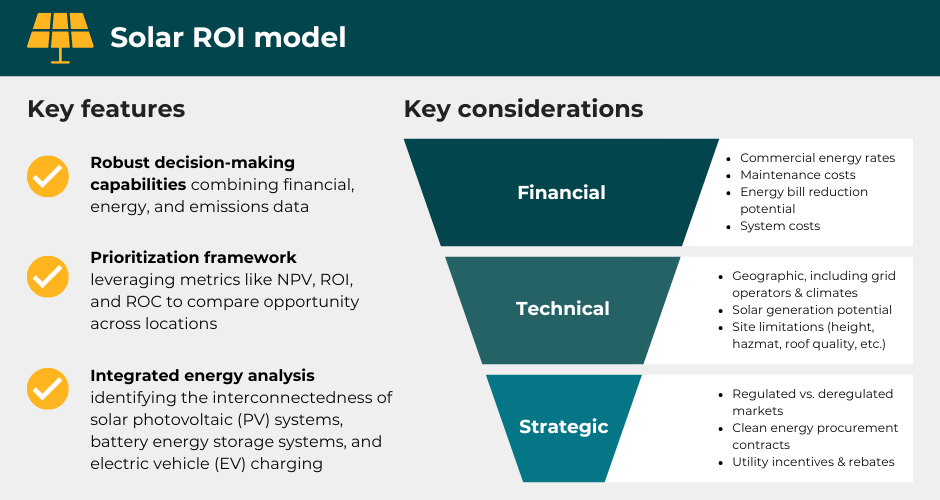Demonstrating the value of onsite solar generation & storage
Challenge
Shifting to clean energy, whether through onsite generation or clean energy procurement, is a critical component of many companies’ climate transition strategies. Our global retailer client was no exception and had set ambitious Scopes 1-3 GHG reduction targets. This included a goal of 100% clean energy in global operations.
To reach this goal, our client considered a variety of initiatives, including power purchase agreements (PPAs), green tariffs, renewable energy certificates (RECs), and onsite solar. While the company understood the theoretical potential of onsite generation, they were skeptical of making further investments – our client had previously installed solar arrays that didn’t meet return on investment (ROI) or energy generation expectations.
As a result, our client was experiencing a variety of internal barriers to the energy transition, including:
Given their challenging previous experience with onsite solar, teams succumbed to a narrative that “solar simply doesn’t work.”
The team had siloed processes for monitoring, managing, and maintaining existing onsite solar systems.
It wasn’t clear how existing systems had performed against expectations communicated during the original installation.
The Sustainability team was supportive, while the Energy team was still grappling with the financial and operational challenges from prior investments.
Given their challenging previous experience with onsite solar, teams succumbed to a narrative that “solar simply doesn’t work.”
The team had siloed processes for monitoring, managing, and maintaining existing onsite solar systems.
It wasn’t clear how existing systems had performed against expectations communicated during the original installation.
The Sustainability team was supportive, while the Energy team was still grappling with the financial and operational challenges from prior investments.
The technological, regulatory, and financial landscape for onsite solar and battery storage has transformed since our client’s first installation. Despite reservations among the US team, the company was experiencing pressure from international teams, who had achieved ROI and energy benefits from onsite solar arrays, and US-based competitors, who had moved ahead with new onsite energy generation systems.
The retailer asked Earth Finance to evaluate the qualitative and quantitative potential of onsite solar generation and identify pathways to unlock positive ROI and GHG reduction (i.e., Return on Carbon) benefits.
Our approach
Our team worked with the retailer to demonstrate the value of generating and storing their own energy using a location-specific approach. To empower data-driven decision-making, we built a granular, all-in-one model to calculate the ROI and Return on Carbon (ROC) benefits of numerous potential sites. Here’s an overview of our process:
1) Retrospective analysis. We began with a retrospective analysis to understand what went wrong with existing solar sites. We found that many systems were undersized, meaning our client spent a lot of capital on systems that weren’t big enough to make a meaningful dent in energy supply, and they had let tax credits and incentive opportunities slip through the cracks. Both contributed to unfavorable ROIs.
2) Landscape assessment. We then analyzed sites where solar was working well across our client’s domestic and international locations to uncover what factors drove success. As part of the assessment, we analyzed the market, technology, and policy landscape to validate key assumptions and determine ROI and ROC impacts.
3) Site prioritization. Next, we developed a framework to prioritize sites based on solar generation potential, commercial utility rates, availability of credits and incentives, and more. This allowed us to whittle down hundreds of sites to those with the highest ROI and ROC potential.
4) Site evaluation. To help our retail client further optimize site selection, we built a multi-attribute decision model to evaluate the financial, operational, and decarbonization impacts of various locations. Using inputs like solar incidence, energy storage capacity, and permitting timelines, the model calculates net present value (NPV), ROI, and ROC to compare opportunity across physical locations.
Solar ROI model functionality: A closer look
Our solar ROI model integrates a variety of financial, technical, and strategic considerations into its calculations. The result is a flexible, easy-to-use tool that combines detailed site assessment and granular project financing in one platform.

Project outcomes
Our retail client now has a repeatable process and tool for screening pilot sites that can fold into broader investment governance and strategic decision-making frameworks. They moved from a position of skepticism about the ROI and ROC potential of onsite solar to building a new pipeline of viable onsite solar and battery storage opportunities and are looking for ways to scale this program domestically and internationally.
The team is fully equipped to:
- Evaluate solutions that can generate ROI- and ROC-positive energy.
- Negotiate from a position of strength with onsite energy system vendors.
- Comply with regulations from the California Air Resources Board (CARB).
- Leverage US Inflation Reduction Act and state-level tax credits and incentives.
- Increase resilience in areas with lower grid reliability.
- Accelerate progress toward their 100% clean energy goal.
Key wins
40+ sites
Locations in the queue for onsite solar and battery storage evaluation
6-10 years
Average payback period for recommended sites
330K MT CO2
Cumulative tons of CO2 expected to be saved
50+ hours
Training delivered to build internal analytical capacity
Although this project was focused on onsite solar generation and storage, our client is using the same model to consider investments in energy efficiency, demand reduction, electric vehicle (EV) charging, microgrids, and more. The end result is the same: a granular, location-specific decision tool leveraging comparable metrics rooted in ROI and ROC.
Need support evaluating the potential of your own energy transition strategy? Our team helps companies across a wide variety of industries deploy transition plans focused on operational and financial feasibility.
Get in touch


